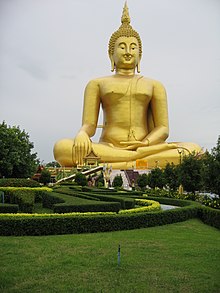Great Buddha of Thailand
| พระพุทธมหานวมินทรศากยมุนีศรีวิเศษชัยชาญ (Phra Phuttha Mahanawamintra Sakayamunee Sri Visejchaicharn) | |
 | |
| Coordinates | 14°35′35.60″N 100°22′40.02″E / 14.5932222°N 100.3777833°E |
|---|---|
| Location | Wat Muang, Wiset Chai Chan, Ang Thong, Thailand |
| Type | Buddha statue in Maravijaya attitude |
| Material | Concrete |
| Height | 92 metres (302 ft) |
| Completion date | 2008 |
| Dedicated to | Buddha (Guatama) |
The Great Buddha of Thailand, also known as The Big Buddha, The Big Buddha of Thailand, Phra Buddha Maha Nawamin, and Mahaminh Sakayamunee Visejchaicharn (Thai: พระพุทธมหานวมินทรศากยมุนีศรีวิเศษชัยชาญ; RTGS: Phra Phuttha Maha Nawaminthara Sakkayamuni Si Wiset Chai Chan), was in November 2018 the tallest statue in Thailand, the second tallest statue in Southeast Asia, and the ninth-tallest in the world.[1]
Located in the temple in Ang Thong Province,[2] this statue stands 92 m (300 ft) high, and is 63 m (210 ft) wide. Construction commenced in 1990, and was completed in 2008. It is painted gold and made of concrete.[3] The Buddha is in the seated posture called Maravijaya Attitude.
The statue was built following the order of Phra Kru Vibul Arjarakhun, the first abbot of Wat Muang temple, in order to commemorate the King Bhumibol of Thailand. The statue was built using the donated money from faithful Buddhists considering as the act of making merit. The budget spent on the statue was roughly 104,200,000 baht.
Names[]
The statue's formal name, Phra Phuttha Mahanawamintra Sakayamunee Sri Visejchaicharn (Thai: พระพุทธมหานวมินทรศากยมุนีศรีวิเศษชัยชาญ), was given by Phra Khru Vibul Arjarakun, and means "the Lord Buddha of Wiset Chai Chan, Built in Honor of King Bhumibol." The name is a blend of Sanskrit words: Phra Phuttha (lit. 'Lord Buddha', Sanskrit varabuddha); Mahanawamintra (Bhumibol's royal title, Sanskrit mahānavamindra), Sakayamunee (Sanskrit śākyamunī), and Visejchaicharn (Sanskrit śrīviśeṣajayajāña)
The statue is also known as Luangpho Yai (หลวงพ่อใหญ่) or Luangpho To (หลวงพ่อโต); neither terms refer to any specific Buddha statue. The names literally mean Big Buddha, and are used for any colossal Buddha statue.
See also[]
- Buddhism in Thailand
- Buddhist art
- Laykyun Sekkya
- List of tallest statues
- Other tallest statues in Thailand
- Phra Phuttha Chok at , the 2nd-tallest (75 m.)
- Guan Yin at , the 3rd-tallest (69 m.)
- Luangpho Yai, the 4th-tallest (59.2 m.)
- Phuket Big Buddha, the 5th-tallest (45 m.)
References[]
- ^ The Tallest Statues In The World, worldatlas.com. November 2018.
- ^ The Biggest Buddha in Thailand ?
- ^ How Big is The Biggest Buddha Statue? | Dimensions Guide
External links[]
| Wikimedia Commons has media related to Phra Buddha Maha Nawamin Sakayamuni Sri Wisetchaichan. |
- Outdoor sculptures in Thailand
- Colossal Buddha statues
- Concrete Buddha statues
- 2008 sculptures
- Tourist attractions in Thailand
- Ang Thong province
- Religious buildings and structures completed in 2008
- Concrete sculptures
- Buddha statues in Thailand
- Statues in Thailand
- 2008 establishments in Thailand
- Buddhism stubs
